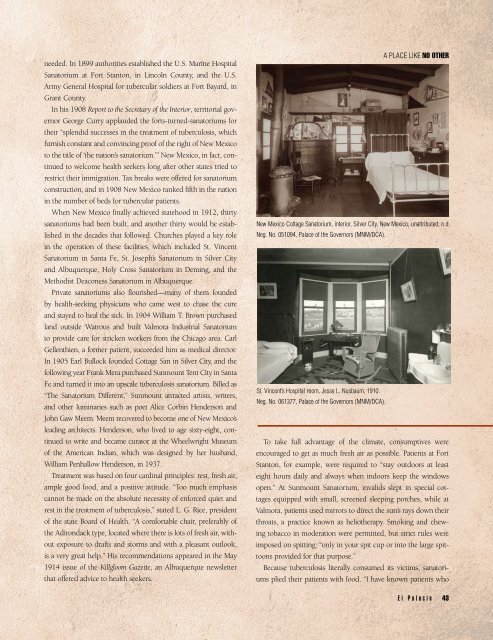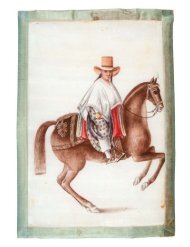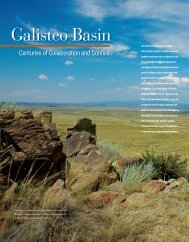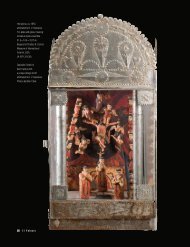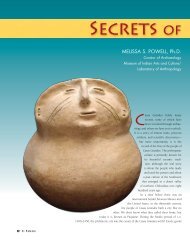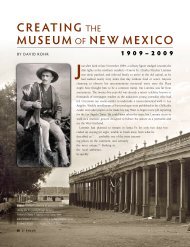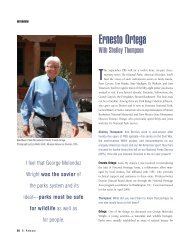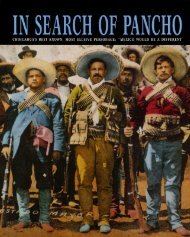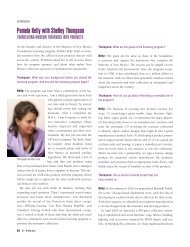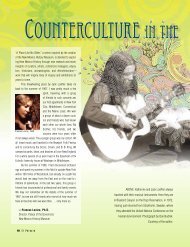Chasing the Cure in New Mexico - El Palacio Magazine
Chasing the Cure in New Mexico - El Palacio Magazine
Chasing the Cure in New Mexico - El Palacio Magazine
You also want an ePaper? Increase the reach of your titles
YUMPU automatically turns print PDFs into web optimized ePapers that Google loves.
needed. In 1899 authorities established <strong>the</strong> U.S. Mar<strong>in</strong>e Hospital<br />
Sanatorium at Fort Stanton, <strong>in</strong> L<strong>in</strong>coln County, and <strong>the</strong> U.S.<br />
Army General Hospital for tubercular soldiers at Fort Bayard, <strong>in</strong><br />
Grant County.<br />
In his 1908 Report to <strong>the</strong> Secretary of <strong>the</strong> Interior, territorial governor<br />
George Curry applauded <strong>the</strong> forts-turned-sanatoriums for<br />
<strong>the</strong>ir “splendid successes <strong>in</strong> <strong>the</strong> treatment of tuberculosis, which<br />
furnish constant and conv<strong>in</strong>c<strong>in</strong>g proof of <strong>the</strong> right of <strong>New</strong> <strong>Mexico</strong><br />
to <strong>the</strong> title of ‘<strong>the</strong> nation’s sanatorium.’” <strong>New</strong> <strong>Mexico</strong>, <strong>in</strong> fact, cont<strong>in</strong>ued<br />
to welcome health seekers long after o<strong>the</strong>r states tried to<br />
restrict <strong>the</strong>ir immigration. Tax breaks were offered for sanatorium<br />
construction, and <strong>in</strong> 1908 <strong>New</strong> <strong>Mexico</strong> ranked fifth <strong>in</strong> <strong>the</strong> nation<br />
<strong>in</strong> <strong>the</strong> number of beds for tubercular patients.<br />
When <strong>New</strong> <strong>Mexico</strong> f<strong>in</strong>ally achieved statehood <strong>in</strong> 1912, thirty<br />
sanatoriums had been built, and ano<strong>the</strong>r thirty would be established<br />
<strong>in</strong> <strong>the</strong> decades that followed. Churches played a key role<br />
<strong>in</strong> <strong>the</strong> operation of <strong>the</strong>se facilities, which <strong>in</strong>cluded St. V<strong>in</strong>cent<br />
Sanatorium <strong>in</strong> Santa Fe, St. Joseph’s Sanatorium <strong>in</strong> Silver City<br />
and Albuquerque, Holy Cross Sanatorium <strong>in</strong> Dem<strong>in</strong>g, and <strong>the</strong><br />
Methodist Deaconess Sanatorium <strong>in</strong> Albuquerque.<br />
Private sanatoriums also flourished—many of <strong>the</strong>m founded<br />
by health-seek<strong>in</strong>g physicians who came west to chase <strong>the</strong> cure<br />
and stayed to heal <strong>the</strong> sick. In 1904 William T. Brown purchased<br />
land outside Watrous and built Valmora Industrial Sanatorium<br />
to provide care for stricken workers from <strong>the</strong> Chicago area. Carl<br />
Gellenthien, a former patient, succeeded him as medical director.<br />
In 1905 Earl Bullock founded Cottage San <strong>in</strong> Silver City, and <strong>the</strong><br />
follow<strong>in</strong>g year Frank Mera purchased Sunmount Tent City <strong>in</strong> Santa<br />
Fe and turned it <strong>in</strong>to an upscale tuberculosis sanatorium. Billed as<br />
“The Sanatorium Different,” Sunmount attracted artists, writers,<br />
and o<strong>the</strong>r lum<strong>in</strong>aries such as poet Alice Corb<strong>in</strong> Henderson and<br />
John Gaw Meem. Meem recovered to become one of <strong>New</strong> <strong>Mexico</strong>’s<br />
lead<strong>in</strong>g architects. Henderson, who lived to age sixty-eight, cont<strong>in</strong>ued<br />
to write and became curator at <strong>the</strong> Wheelwright Museum<br />
of <strong>the</strong> American Indian, which was designed by her husband,<br />
William Penhallow Henderson, <strong>in</strong> 1937.<br />
Treatment was based on four card<strong>in</strong>al pr<strong>in</strong>ciples: rest, fresh air,<br />
ample good food, and a positive attitude. “Too much emphasis<br />
cannot be made on <strong>the</strong> absolute necessity of enforced quiet and<br />
rest <strong>in</strong> <strong>the</strong> treatment of tuberculosis,” stated L. G. Rice, president<br />
of <strong>the</strong> state Board of Health. “A comfortable chair, preferably of<br />
<strong>the</strong> Adirondack type, located where <strong>the</strong>re is lots of fresh air, without<br />
exposure to drafts and storms and with a pleasant outlook,<br />
is a very great help.” His recommendations appeared <strong>in</strong> <strong>the</strong> May<br />
1914 issue of <strong>the</strong> Killgloom Gazette, an Albuquerque newsletter<br />
that offered advice to health seekers.<br />
<strong>New</strong> <strong>Mexico</strong> Cottage Sanatorium, <strong>in</strong>terior, Silver City, <strong>New</strong> <strong>Mexico</strong>, unattributed, n.d.<br />
Neg. No. 051094, Palace of <strong>the</strong> Governors (MNM/DCA).<br />
St. V<strong>in</strong>cent’s Hospital room, Jesse L. Nusbaum, 1910.<br />
Neg. No. 061377, Palace of <strong>the</strong> Governors (MNM/DCA).<br />
A PLACE LIKE No o<strong>the</strong>r<br />
To take full advantage of <strong>the</strong> climate, consumptives were<br />
encouraged to get as much fresh air as possible. Patients at Fort<br />
Stanton, for example, were required to “stay outdoors at least<br />
eight hours daily and always when <strong>in</strong>doors keep <strong>the</strong> w<strong>in</strong>dows<br />
open.” At Sunmount Sanatorium, <strong>in</strong>valids slept <strong>in</strong> special cottages<br />
equipped with small, screened sleep<strong>in</strong>g porches, while at<br />
Valmora, patients used mirrors to direct <strong>the</strong> sun’s rays down <strong>the</strong>ir<br />
throats, a practice known as helio<strong>the</strong>rapy. Smok<strong>in</strong>g and chew<strong>in</strong>g<br />
tobacco <strong>in</strong> moderation were permitted, but strict rules were<br />
imposed on spitt<strong>in</strong>g: “only <strong>in</strong> your spit cup or <strong>in</strong>to <strong>the</strong> large spittoons<br />
provided for that purpose.”<br />
Because tuberculosis literally consumed its victims, sanatoriums<br />
plied <strong>the</strong>ir patients with food. “I have known patients who<br />
<strong>El</strong> <strong>Palacio</strong> 43


